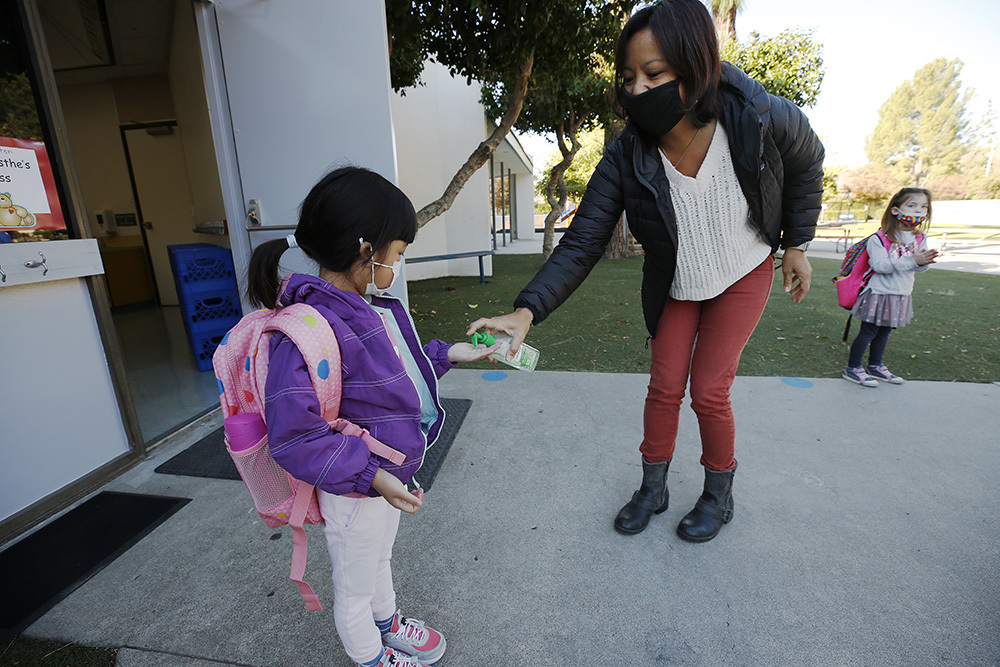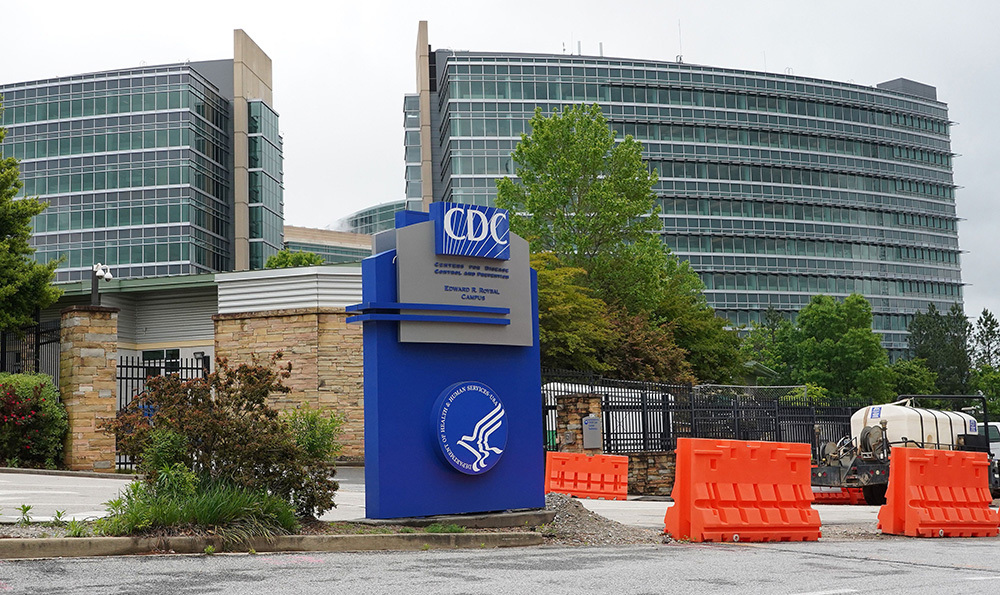The Week in COVID & Education Policy: 1.3 Million Missing Students, CDC Says Youth Should Get Vaccines and 18 More Key Education Updates

This is our weekly briefing on how the pandemic is shaping schools and education policy, vetted, as always, by AEI Visiting Fellow John Bailey. Click here to see the full archive. Get this weekly roundup, as well as rolling daily updates, delivered straight to your inbox — sign up for The 74 Newsletter.
Study Finds Low Risk for Teachers: New study finds school staff are no more likely to contract COVID-19 at work than they are in day-to-day life in their communities.
- “Despite high reported COVID-19 cases among students and staff, and frequent within-school exposures, we found no detectable increase in seroprevalence among school staff above the community seroprevalence. These findings corroborate claims that, with appropriate mitigation strategies, in-person schooling is not associated with significantly increased risk for school staff.”

June 25, 2021 — The Big Three
A Million Missing Students: 1.3 million students disappeared from public school rolls during the 2020-21 school year, according to a new report from Education Week that analyzes available state-collected data.
- The change represents a 3 percent drop in enrollment across the board — and it could be larger.
- The most severe enrollment losses occurred in Maine, Mississippi, New Hampshire and Vermont, all of which lost more than 4.3 percent of [their] students.”
- “In Maine, the number of students who were home-schooled alone or in learning pods increased by 32 percent during the pandemic.”
- State by state data are available from Education Week.

Centers for Disease Control and Prevention Says Teens, Young Adults Should Continue to Get the Vaccine; Food and Drug Administration Adds a Warning:
- The CDC says 323 cases of heart inflammation have been verified in people who received the Pfizer or Moderna COVID-19 vaccine. Cases emerged mostly after the second dose. Of the 323 cases, 295 were discharged from the hospital, nine remained hospitalized as of last week and 14 were not hospitalized. Presentation and data here.
- The CDC says the findings do not change the basic recommendation that all people 12 and older should receive either the Pfizer or Moderna vaccine.
- The FDA will include a warning statement about the risks and characteristics of this rare condition.
- “The facts are clear: this is an extremely rare side effect, and only an exceedingly small number of people will experience it after vaccination,” wrote 13 leading health associations, including the American Academy of Pediatrics.
Rising Worry About the Delta Variant: U.S. officials are nervously watching the Delta variant overseas and are concerned with its implications for the U.S.
- The share of Delta variant COVID-19 cases doubles in Germany in a week.
- In Israel, Delta variant blamed as schools reportedly see COVID-19 cases triple.
- A quarter-million children in England missed school last week because of COVID-19 infections, self-isolation or school closures, making it the most disrupted week since schools fully reopened in March. That’s a tripling of cases in just a week.
- Dr. Anthony Fauci declared the Delta variant “greatest threat” to the nation’s efforts to eliminate COVID-19.
- From The New Yorker:
- “It hasn’t yet been conclusively shown that Delta is more lethal, but early evidence from the U.K. suggests that, compared to Alpha, it doubles the risk of a person’s being hospitalized.”
- One of the most disturbing aspects of India’s surge was that many children fell ill. And yet there is currently no data to suggest that Delta causes severe illness in a greater proportion of kids; instead, it seems likely that the sheer transmissibility of the variant simply resulted in a higher absolute number of infected children.”
- “For those who remain unvaccinated, by choice or by chance, Delta represents the latest installment in an ongoing series of horrors.”
Federal Updates
National Telecommunications and Information Administration: Unveiled a new broadband mapping tool with much more detailed data. (Press release)
Federal Communications Commission: The $7 billion Emergency Connectivity Fund application window opens June 29.
Institute of Education Sciences: Released its First Look at the Impact of the Coronavirus Pandemic on Undergraduate Student Enrollment, Housing and Finances
- 22 percent of students at private, for-profit less-than-two-year colleges took a leave of absence, in contrast to students at other types of institutions.
- Students without Pell Grants moved back to their permanent address at higher rates (26 percent) than students with Pell Grants (16 percent).
- Only 34 percent of students received technology or technical services from their college. Black students (40 percent) were more likely to receive assistance than white students (31 percent).
- Read the full report.
Internal Revenue Service: Launched a Child Tax Credit tool for low-income families, but some find it hard to use.
City & State News
California: The Los Angeles Board of Education approved a record $20 billion budget for the upcoming academic year — a massive influx of funding made possible by two unprecedented occurrences: pandemic relief money and record state tax revenues.
- Officials laid out a strategy to hire 930 psychologists and psychiatric social workers, an increase of more than 80 percent; 2,190 teachers, an increase of 8 percent; and 770 custodial workers, a 25 percent increase.
Colorado: Gov. Jared Polis signed two Colorado Comeback bills into law that will provide tutoring for K-12 students.
- HB21-1234 allocates $5 million to the newly created Colorado high-impact tutoring program to provide grant funding to local education providers, to create high-impact tutoring programs to address student learning loss and unfinished learning resulting from the COVID-19 pandemic.
Florida: State department of education released assessment results showing that districts with higher rates of in-person instruction had more consistent learning outcomes between 2019 and 2022. Achievement gaps also narrowed for Florida’s African American and Hispanic students, who experienced less of a decline (3 percent) than white students (4 percent).
Illinois: Chicago public high school graduates would be guaranteed three more months of free, high-speed internet service — and those going on to city colleges would get the benefit for up to three years, thanks to a large philanthropic consortium.
Indiana: Counseling helps students cope with pandemic trauma at Indianapolis summer program.
COVID-19 Research
Kids, COVID and the Delta Variant: A resource for parents from David Leonhardt
- “Delta does appear to be worse than most [other variants] … It may be the worst variant yet, in terms of contagiousness and severity. Yet it also seems to be in the same broad range as the earlier ones.”
- “There are still enough COVID uncertainties that some precautions can make sense for children, like wearing masks indoors or avoiding crowded places.”
CDC Says Young Adults Less Likely to Take COVID-19 Vaccine: From Reuters.
- “Of the 57 percent [of] American adults who received at least one vaccine dose by May 22, coverage was highest among people 65 or older and lowest among people aged 18 to 29, according to an analysis of vaccine rates published on Monday in the CDC’s Morbidity and Mortality Weekly Report.“
- “The lowest rates of vaccination were among lower income, non-Hispanic Black adults aged 18-39 with lower levels of education who lacked health insurance and live outside of major cities, according to the report.”
Vaccine Approval for Children: Dr. Bechara Choucair, the White House vaccinations coordinator, told KXAN that the necessary federal entities won’t approve the use of vaccines in younger children until “possibly by the end of the year or early 2022.”
The 60-Year-Old Scientific Screwup That Helped COVID-19 Kill: Via Wired. Long piece but worth your time as this has implications for the 3 foot-versus-6 foot debate in schools.
- “According to the medical canon, nearly all respiratory infections transmit through coughs or sneezes: Whenever a sick person hacks, bacteria and viruses spray out like bullets from a gun, quickly falling and sticking to any surface within a blast radius of 3 to 6 feet.”
- “The distinction between droplet and airborne transmission has enormous consequences. To combat droplets, a leading precaution is to wash hands frequently with soap and water. To fight infectious aerosols, the air itself is the enemy. In hospitals, that means expensive isolation wards and N95 masks for all medical staff.”
- One scientist had “become fixated on the WHO recommendation that people stay 3 to 6 feet apart from one another. As far as he could tell, that social distancing guideline seemed to be based on a few studies from the 1930s and ’40s. But the authors of those experiments actually argued for the possibility of airborne transmission, which by definition would involve distances over 6 feet. None of it seemed to add up.”
- “On Friday, April 30, the WHO quietly updated a page on its website. In a section on how the coronavirus gets transmitted, the text now states that the virus can spread via aerosols as well as larger droplets. As Zeynep Tufekci noted in The New York Times, perhaps the biggest news of the pandemic passed with no news conference, no big declaration. If you weren’t paying attention, it was easy to miss.”
- “In early May, the CDC made similar changes to its COVID-19 guidance, now placing the inhalation of aerosols at the top of its list of how the disease spreads. Again though, no news conference, no press release.“
Study on Effectiveness of Mask Mandates: Study suggesting that mask wearing worked, but government mask mandates didn’t correlate with mask wearing.
- “At a time where mask-wearing is decreasing and mask mandates are being lifted, we find that mask-wearing is associated with a notable reduction in transmission, and that factors other than mandates must have contributed to the worldwide uptake of mask-wearing in 2020.”
Study on Effectiveness of Shelter in Place (SIP): An NBER paper finds “SIP policies did not lead to reductions in excess deaths.”
- “To understand the net effects of SIP policies, we measure the change in excess deaths following the implementation of SIP policies in 43 countries and all U.S. states.”
- “At the U.S. state level, excess mortality increases in the immediate weeks following SIP introduction and then trends below zero following 20 weeks of SIP implementation.”
- “These descriptive figures suggest that the implementation of SIP policies does not lead to reductions in excess mortality. In fact, a positive association was observed both when accounting for the expedience of the SIP implementation and the duration of SIP policies.”
Viewpoints
State Equitable Recovery Coalition: Launched by the National Governors Association to drive equitable economic recovery and growth championed by governors of states and territories.
Grants to Close Teacher Diversity Gaps: With lead funding from The Walton Family Foundation, NewSchools is offering up to $2.5 million in grants to support efforts focused on recruiting, supporting and retaining educators of color.
Invest in Quality Curricula Now for Long-Term Returns: Via EdReports. As educators determine budget choices, new stimulus funds offer a powerful opportunity to make a long-term investment in students.
Reimagining Post-Pandemic Classrooms for Today’s Learners: Interesting piece on school and classroom design from Ed Tech Magazine.
Why Are We Turning Our Backs on Remote Learning?: EdWeek essay from Theresa Rouse, superintendent of Joliet Public Schools District 86, in Illinois
- “Advocates need to take care. Ham-fisted mandates banning or requiring remote learning are likely to throw the baby out with the bathwater.”
- “As a district superintendent, it is essential that I have options to offer families that help place their children in the best learning environments for them. Allowing parents a choice among fully online, hybrid and in-person learning is the right thing to do as we move into a post-pandemic world. Why would we go backward when we can augment our options for students to better ensure their success?”
The Resilience of K-12 Teachers: Tyton Partners survey
- 46 percent of teachers report being less effective this year than in years past.
- 66 percent report students experienced less academic growth than in a typical year.
- 89 percent reported their performance improved as it relates to incorporating technology into instruction.
- 99 percent plan to continue incorporating tools and techniques that they adopted as a result of COVID-19.
…And on a Lighter Note
Be as excited for the weekend as Sierra Schmidt is to compete.
ICYMI @The74
Weekend Reads: In case you missed them, our top five stories of the week:
- Youth Vaccination: When Parents Disagree Over Doses for Kids: How Mothers’ Caretaking Instinct May Be Slowing Youth COVID Vaccination (Read more)
- Enrollment: Falling Birth Rates Spur Clash over Race and School Choice in Michigan (Read more)
- Curriculum: Can Right Answers Be Wrong? Latest Clash Over ‘White Supremacy Culture’ Unfolds in Unlikely Arena: Math Class (Read more)
- Science: Cicadas During COVID — A ‘Golden Moment’ For Classroom Engagement At the End of an Isolating School Year (Read more)
- Cardona: Education Secretary Calls on Charter Leaders to Bolster Teacher Diversity, Eliminate For-Profit Operators (Read more)
Disclosure: John Bailey is an adviser to the Walton Family Foundation, which provides financial support to The 74.
Get stories like these delivered straight to your inbox. Sign up for The 74 Newsletter

;)
